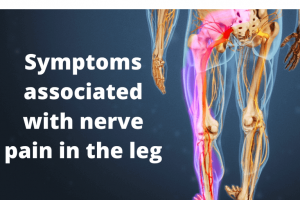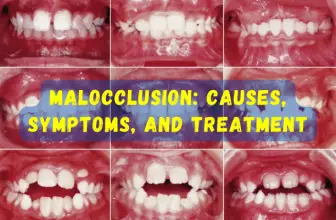Nerve Pain In The Leg – Causes, Symptoms, Treatment, Exercise

Nerve pain in the leg is typically described as intense, electric-like, or shooting pain. Mostly, a dull ache may occur in some individuals. It may also generate a sensation of running hot or cold water through the legs or thighs. Nerve pain is the symptoms of different conditions like cancer, diabetes, HIV, compression, or inflammation in nerves. Nerve pain in the leg may be irregular or constant.
Nutritional deficiencies may also cause nerve damage. Besides these causes, nerves in the legs may become degenerated or inflamed due to some mechanical or chemical irritants. These degenerated, inflamed or compressed nerves cause pain in the legs. Nerve pain in the leg has different types. They are treated with many home-based remedies, prescribed medications, and surgical treatments.
What Are The Types Of Nerve Pain In The Legs?
The most common types of nerve pain in the legs are given below:
Radiculopathy:
It is the medical term used for sciatica. Radiculopathy includes leg pain that arises from the problem in the nerve roots of the lumbar or sacral spine. It typically affects one leg. In this type, pain may induce when nerve roots become inflamed, damaged, or compressed. Affected nerve root specifies the character of the pain or sensations.
The pain from these nerve roots is marked by:
- Pain arises in the lower back or buttock and passes down the thighs, calf, and foot.
- Numbness originates from the calf, foot, or toes.
- Weakness feels in the hips, thighs, or feet muscles.
Besides these, other sensations may occur depending upon the type of the individual. These sensations include warm or cold water running down the thighs, the feeling of pins and needles in legs, or the foot dipped in hot water.
Peripheral Neuropathy:
Peripheral neuropathy includes damage to one or more nerves in the peripheral nervous system. This type of neuropathy commonly occurs in the legs and is caused by diabetes. Common symptoms of this diabetic peripheral neuropathy include:
- Pain that arises in the toes and then slowly moves upwards. It is called the Stocking-glove pattern.
- Numbness in the legs, feet, and knees.
- Weakness is felt in the ankles and toes in the later stage of this neuropathy.
Peripheral neuropathy pain mainly affects both legs.
Lumbosacral Radiculoplexus Neuropathy:
This type of neuropathy occurs when the blood supply to nerves in the legs is blocked. Typically, inflammation in blood vessels heading towards the leg nerves leads to blood blockage. So, this reduced blood supply results in nerve damage and, ultimately, nerve pain in the legs.
Diabetes is the leading cause of this neuropathy. But its causes may include some other issues as well. Common symptoms of Lumbosacral radiculoplexus neuropathy include:
- The pain usually originates in a specific location, for example, foot, leg, thigh, hips, or buttocks. However, this pain ultimately moves to other areas of the leg.
- Numbness and prickling sensations feel in the affected areas.
- Weakness in the leg and feet muscles.
- Individuals with this neuropathy fall due to loss of balance.
As many nerves affect neuropathy simultaneously. So, it may result in nerve pain in both legs together or one by one.
Peroneal Neuropathy:
This type may be caused due to compression of the peroneal nerve present near the knee. Typically, this results in nerve pain in the legs. Symptoms of peroneal neuropathy include:
- Numbness feels in the 1st toe web space, in the upper part of the foot, and along the sides of the legs.
- Foot Drop, marked by the incapacity to raise the foot or the catch by the toe during walking.
Pain is not common in this type but, if peroneal neuropathy occurs by any trauma, this may result in nerve pain in the leg.
Meralgia Paresthetica:
Compression in the lateral femoral cutaneous nerve present in the thigh may result in Meralgia Paresthetica. This compression then leads to nerve pain in the legs and ultimately to the feet. Symptoms of this type of nerve pain include:
- Sensational vibrations in the thigh region.
- Coldness in the affected region.
- Burning or achy pain in the front side of the thigh or on the upper side.
Meralgia Paresthetica pain typically raises while walking or sudden lift after extended sitting.
Tarsal Tunnel Syndrome:
Compression in the foot’s tarsal tunnel results in this syndrome. This compression leads to dysfunction of the tibial nerve, which ultimately originates nerve pain in the leg, feet, and toe. Tarsal tunnel syndrome causes:
- Burning sensation in feet and toe.
- Numbness in the bottom of the foot.
- Sharp, searing pain in the bottom of the foot as well as in the inner ankle joint.
Furthermore, these symptoms become worse while doing any strenuous physical activity or at night. But these symptoms can be better after taking some rest.
Neurogenic Claudication:
Narrowing of the spinal canal, called spinal stenosis, causes compression in the spinal cord. This compression results in Neurogenic Claudication. Besides this, Neurogenic Claudication may also provoke disc herniation, abnormal bone growth (bone spurs), or forward slippage of the vertebra (spondylolisthesis).
This type typically occurs in both legs simultaneously. Most common symptoms of this type include:
- Pain felt while standing, walking, and sitting, etc.
- Weakness while doing any physical activity, especially during leg movement.
- Numbness while doing any movement.
Nerve pain in the legs of this type may increase while doing upright exercises and moving spinal backward. But this pain may reduce while moving the spinal slowly in the forward and lying-in straight position.
What Are The Causes Of Nerve Pain In The Legs?

Some commonly known causes of nerve pain in the legs are described below:
- Diabetes is the leading cause of nerve damage and pain in the legs. Researchers think that with time, high blood sugar levels harm nerves of the whole body, especially in the legs. It leads to interfering negatively with the nerve abilities to transmit signals. Consequently, this outcome results in diabetic neuropathy. Besides this, high blood sugar destroys the walls of the capillaries (small blood vessels), which provide nutrients and oxygen to the nerves.
- Human immunodeficiency virus (HIV) is also one of the leading causes of nerve damage and, ultimately, pain in different body regions. Primarily, this virus affects sensory and motor nerves in the distal parts of the limbs resulting in HIV neuropathy. This virus can affect many nerves simultaneously or affect only one at a time.
It is found that HIV neuropathy has become standard worldwide among HIV patients nowadays. These patients have affected more peripheral nerve disorders. HIV neuropathy is always based on clinical examination, patient’s history, and advanced supporting laboratory investigations.
- The deficiency of specific vitamins and nutrients leads to nerve damage or nerve pain in the legs. For example, mineral deficiency can cause damage to the peripheral nerves resulting in nerve pain in the legs or at other locations. Vitamin B12, vitamin B6, and copper are a few nutrients whose deficiency can cause nerve pain.
- Excessive intake of toxins, alcohol, and certain heavy metals like mercury, arsenic, and thallium, etc., can typically lead to nerve damage and pain in the legs.
- Lyme disease, if left untreated, can lead to nerve damage and pain in limbs, especially in the legs. Over time, this disease shows some neurological disorders. However, peripheral neuropathy and numbness, weakness, and burning sensation in hands and legs are the most common symptoms of this disease.
- Cancer and other tumors cause nerve damage in limbs as tumorous cells increase in numbers in the body. They easily compress surrounding nerves. Consequently, this compression of nerves leads to nerve disability resulting in nerve pain in the legs.
- Physical injuries can cause nerve pain in the legs if nerves become crushed, compressed, or damaged.
- Shingles can be characterized by a painful condition named postherpetic neuralgia. This type of nerve pain is particularly sudden but severe.
Other risk factors that cause nerve pain in legs:
Besides these causes, as mentioned above, certain risk factors induce nerve pain in the legs.
- Being overweight is one of the significant risk factors for nerve damage. Increased body fat compresses body nerves and injuries them, resulting in nerve pain in the legs and other affected areas. Obesity also increases the risks of suffering from diabetes which may lead to diabetic neuropathy.
- Kidney Diseases damage kidneys. Resultantly, kidneys become unable to remove toxins from the body. These toxins accumulate in the body cells and affect nerves. As a result, nerves become damaged and cause pain in limbs, especially in legs and feet.
- Smoking constricts and stiffens blood vessels resulting in reduced blood flow to the legs and feet. Gradually, this leads to damaged nerves, mainly peripheral nerves.
- Poor blood sugar control can cause nerve damage. Both low and high blood sugar levels can harm the body system as increased levels lead to diabetes and ultimately to diabetic neuropathy. Likewise, low sugar level affects the oxygen-carrying capacity of the blood. In both cases, nerve inflammation occurs, resulting in nerve damage.
- Age may be the cause of nerve pain in the legs in some cases. With the passage of time, our diet changes. So, any nutritional deficiency with age can lead to nerve damage and nerve pain in different locations, including legs. Also, body functioning has external impacts over time. Aged people have low metabolic rates. Other diseases with time can cause nerve damage.
- Poor body posture is one of the leading causes of nerve pain in the legs. For example, if we don’t move properly or sleep in a good posture, this can create leg nerves compression. That automatically leads to nerve pain in the leg.
- Jobs like military services, challenging exercises, or labor work affect nerves in the legs by inducing pressure during strenuous physical activity.
Once nerves become damaged, it automatically induces pain in affected parts of the body. In addition to this pain, compression or inflammation causes numbness, shooting sensation, and electric-like feeling in affected regions.
Unexplained Causes Of Nerve Pain In The Leg
Despite these causes mentioned above and factors, there are still some unexplained causes for the nerve pain in the legs. In addition, there are specific nerve damages at some points about which neurologists know nothing regarding questions like what, when, and why.
About 15 million to 20 million people have nerve pain in their legs, unidentified as doctors don’t know about their primary cause. It’s likely to affect people with age more than 60 without having any proper and defined reason.
Symptoms Associated With Nerve Pain In The Leg

You may likely feel painful sensations or even uncomfortable without properly functioning nerves. It happens because of damaged nerves that cannot send proper signals to the brain and spinal cord. Following are some signs that give you adequate surety about nerve damage in the legs. Affected areas always show significant symptoms than other non-affected areas of the body.
- Electric-like, shooting or sharp pain felt in the affected leg.
- Tingling or prickling sensation in the leg and the feet.
- Burning agitation thought in the whole leg.
- Weakness in the feet, toe, or the leg while doing any physical activity, moving, or even walking.
- You may feel muscle weakness around the affected nerve in the legs.
- You may fall in some cases due to loss of balance.
- Feeling like you are wearing tight soaks in your feet.
- Loss of reflexes in some cases.
- Chances of paralysis increase in extreme conditions of nerve damage.
- Nerve damage also affects breathing rate and metabolic rates by attacking the digestive system of the body.
- Enhanced sensitivity towards touch.
- Severe foot problems like foot infection, ulcers, toe infection, or joint pains.
When To See Your Doctor?
Slight nerve pain in the legs is common. Luckily, you can quickly reduce little pain through self-care and proper rest. But in some cases, you need to call your doctor for appropriate checkups. In addition, you have to take appropriate medications recommended by your neurologist.
Initially, the pain is mild. So, self-care and selected exercises work. But if symptoms become severe an electric-like sensation starts producing. Then, be in a hurry to meet your doctor. These severe symptoms may include:
- Loss of balance.
- Severe tingling and burning sensation in the legs.
- Extreme muscle weakness in feet and legs.
- Nerve pain induced in the leg due to any injury or traffic accident.
- Numbness and sudden pain in legs.
Complications related to nerve pain in the leg:
Mostly, nerve pain in the legs is not so complicated. Some common symptoms always appear in almost all types of nerve pain in the legs. But in several cases, some complications may merge, which are given below.
- Slight or complete loss of feeling in affected areas of the legs.
- The digestion process of the body disturbs.
- Weakness felt all over the body muscles.
- Loss of bladder function and loss of bowl.
How To Accurately Diagnose Nerve Pain In The Leg?
A proper diagnosis of any disease is essential to treat that disease completely. The diagnostic procedure involves studying the complete medical history of the patients along with their physical examination.
Physical examination and medical history of the patient:
Checking previous medical conditions of the patients by reviewing their medical history is essential. Similarly, a complete physical examination is also required to identify the exact reason for nerve pain in the legs.
Physical Examination:
Your doctor will check for the following things while examining the patient.
- Swallowing in the legs, feet, or on the toe.
- Response to some stimulus like touching with a rod or gently pressing the leg or feet.
- Shooting pain in affected areas like feet, knee, toe, and legs.
The doctor will also examine by tapping on certain joints like the knee or toe to check reflexes in joints. Additionally, this tapping technique will also help to strengthen muscles.
Checking the medical history of the patient:
To treat nerve pain properly, exact identification is needed. So, to identify correctly, the doctor always reviews the medical history of their patients. For example, the doctor may examine the following things in the patient’s medical history.
- Type, nature, and onset of nerve pain in the leg.
- Any injury or accident after which nerve pain starts.
- Duration of the pain.
- Different factors that make the pain better or worse.
- Presence of muscle cramps in the legs.
- Any past primary disease that can be a factor of nerve pain in the leg.
- Current health conditions.
After diagnosing the exact cause, the doctor will take medical imaging and diagnostic testing of the affected leg. These testing and imaging will help the doctor identify the precise reason and suspect any significant problem like infection, trauma, or inflammation. Besides these, this imaging and testing will assist doctors in planning surgery for the patient or making a prescription.
Medical Imaging And Diagnostic Testing Of The Patients
MRI (magnetic resonance imaging), CT scan (computer tomography), plain X-rays, or ultrasound techniques are mainly used to diagnose any type of nerve pain in the leg. In addition, these tests and taking images help identify bone spurs (abnormal bone growth), nerve damage or inflammation, joint infections or tumors, etc.
A short description of this medical imaging and testing is given below.
-
MRI:
This technique involves using radio waves and magnets to take internal images of body parts. For example, it gives detailed imaging of the spinal cord.
-
CT Scan:
This technique consists of a combination of a series of X-rays to take images of spinal nerves and the spinal cord.
-
X-Ray Technique:
To check bone spurs (abnormal bone growth), we use this technique.
-
EMG (Electromyography):
This technique is used to measure the speed of nerve signals. It explains how fast a nerve signal is moving through the affected part.
Ordering Diagnostic Nerve Blocks For Nerve Pain In Legs
Doctors typically call diagnostic nerve blocks to check nerve irritations and nerve compressions. These nerve blocks contain anesthetic solutions that are injected near the affected nerves. If this solution proves helpful in relieving pain, then doctors consider it as a diagnosis of neuropathy.
After a complete diagnosis, the doctor prescribes some medications or treatments. Both surgical and non-surgical treatments are used to cure nerve pain in the legs.
How To Treat Nerve Pain In The Leg Properly?
Slight to moderate nerve pain in the legs can be treated initially with self-care. On the other hand, chronic nerve pains should be treated with doctor consultation. Chronic nerve pains progressively reduce in a few weeks by taking medications.
Each type of nerve pain needs almost the same kind of self-care and treatment. As some factors like a patient’s health, the leading cause of nerve pain and chances of side effects also matter in prescribing medicines.
Home Remedies For Nerve Pain In The Leg
Many home-based self-care remedies prove helpful in reducing nerve pain. These remedies are described below:
-
Regular Exercise:

Regular exercise improves the overall health of patients. It not only nourishes inflamed or damaged nerves back to life. Always start with small walking for some time, and then increase speed and distance daily. Besides, Walking assists in improving blood flow through the legs. Moreover, stretching exercises also prove effective in improving nerve pain.
-
Improve Sitting And Sleeping Postures:
Bad body postures induce nerve and muscle pain in different body parts. To avoid nerve pain, always sit in good body postures. Researchers found that good postures prove marvelous in reducing nerve pain in the legs. Additionally, proper sleep with good postures also shows excellent results in relieving pain.
-
Complete Nutritional Uptake:
Proper uptake of vitamins, nutrients, and minerals results in good health. We all know that every cure related to any disease must require a proper diet. Similarly, any nerve pain in the legs acquires total nutritional intake along with appropriate care.
-
Massaging:
Proper massaging on affected areas can quickly ease nerve pain. People mostly use this home-based technique to avoid any drug medication or painkillers.
Considering non-surgical and surgical techniques for nerve pain in legs After home-based remedies, doctors prescribe non-surgical methods to cure nerve pain. These non-surgical techniques generally include topical treatments, oral medications, steroid injections, or physical therapies. Mostly, non-surgical procedures prove effective in treating nerve damage.
A few non-surgical ways to treat nerve pain are given below.
-
Topical Treatments:
Prescribed topical treatments may consist of gels, patches, creams, or lotions to reduce pain. These ointments apply only to affected areas. And these tropical lotions work amazingly on those areas to ease nerve pain.
-
Antidepressants:
Some antidepressants are available in markets that can control nerve pain. You can use them only on your doctor’s recommendations. Generally, antidepressants work marvelously when using them with anticonvulsants. Remember that these drugs are only effective for a moderate level of nerve pain.
-
Anticonvulsants:
Certain anticonvulsants may help in reducing nerve pain in the legs when using antidepressants drugs. Use them after your doctor’s recommendation. However, these drugs may not prove effective in neuropathy caused by diabetes, cancer, or HIV.
-
Painkillers:
People suffering from severe nerve pain often use potent painkillers. Doctors generally prescribe antidepressants, anticonvulsants, and anti-inflammatory drugs first. These drugs work well in most cases. But in extreme cases, they suggest some opioid painkillers as they prove effective in acute nerve pains. However, opioid painkillers are addictive drugs and may have harmful effects on the body. As excess intake of these drugs makes patients addicted. So, avoid using them without a prescription.
- Electrical Stimulation:
Several electrical stimulation methods are typically used to block pain signals. These electrical stimulation techniques may include rTMS (repetitive transcranial magnetic stimulation) and electrical nerve stimulations. Luckily, both these techniques are painless. But other electrical stimulation techniques consist of surgical methods.
If a patient would not show any recovery using these home-based remedies or non-surgical treatments, then visit a specialist. Your neurologist will suggest effective surgery to cure your nerve pain.
Surgical Treatments For Nerve Pain In The Leg

Doctors recommend surgical treatments in the most severe cases. And mostly when non-surgical methods become ineffective. Despite these, doctors also suggest surgery in one of the following cases.
- Cancer or tumors.
- Severe infection.
- Complete loss of bowel or bladder functions.
- Extreme leg weakness or numbness.
People always primarily visit an average care physician to diagnose and treat nerve pain in the legs. Unfortunately, these primary care physicians can only prescribe some medications or home-based remedies for pain. But in severe cases, they always recommend an excellent specialist to perform some surgical treatments.
Recovery From The Nerve Pain In The Leg
The above-mentioned home remedies and proper medications are essential elements to recover nerve pain in the leg quickly. In addition, a positive mental attitude and back to the job for limited times also prove effective in this recovery process.
Surgical methods take some time to heal correctly. But by following all instructions given by doctors, patients can recover nerve pain completely.
How to avoid nerve pain in the leg by taking some preventive measures?
We all know that prevention is always better than cure. So, always follow preventive measures to avoid nerve pain in the leg. Following are some preventative tips to keep away nerve pain.
-
Manage Blood Sugar Level:
Managing blood sugar level not only helps in avoiding nerve pain, but also reduces diabetic risks. Low and high, both abnormal blood sugar levels can generate nerve inflammation which ultimately leads to nerve pain. So, check your blood sugar level every month and try to maintain a normal range.
-
Daily Exercise:
Regular exercise with proper body stretching and strengthening helps in maintaining good health. Daily exercise assists in keeping away a lot of diseases, including nerve pain. Stretching exercises make muscles strong and healthy. It overall improves nerve health.
-
Take A Healthy Diet:
A healthy diet enriched with all nutrients, minerals, and vitamins is essential for good health. A complete diet is compulsory to cure any disease, along with taking proper medications. Besides fixing, diet also has marvelous results in keeping away many diseases. People who are on a good diet suffer less from diseases than non-healthy eaters.
-
Good Postures:
Good posture while sitting, standing, and walking is essential to avoid any type of nerve pain. Additionally, this could help maintain a good body shape, and avoiding prolonged body sitting results in keeping away nerve pains.
-
Use Comfortable And Good Body Machines:
If you have to sit for an extended period, always use comfortable chairs. Straighten up your neck and spinal cord. Use small stools or small boxes to rest your feet for a prolonged period. Walk with a straightened body and bend on your knees. Don’t lift too many heavyweights. Always take help from another partner to lift heavy things. You are never twisting and lifting at once.
-
Avoid Smoking:
Smoking blocks nerves and induces inflammation in blood vessels. It also causes cancer resulting in cancerous neuropathy. Consequently, this will automatically increase the chances of nerve pain. So don’t smoke.
-
Maintain A Healthy Weight According To Your Age:
Maintaining weight according to your age is essential to avoid diseases. In addition, obesity is a significant factor in generating nerve compression in the legs. That’s why keep checking your weight every three months and try to maintain it.
-
Keep Yourself Safe From Falling:
Falling is a significant factor in damaged nerves. This damage will induce nerve pain. So, always wear comfortable shoes and keep an eye on the road while walking. Also, be careful while climbing up or down the stairs. It will reduce the chances of falling.
Some other precautions that prove good in avoiding nerve pain are given below.
- Proper lifting while doing exercise.
- Relax daily and manage your stress.
- A peaceful work area to perform tasks.
- Explore mind-body connections.
Final Words:
Having nerve pain in the leg makes you feel uncomfortable all day. Sudden pain shootings disturb individuals not only physically but also mentally. We all know that both mental and physical health are essential to work normally and adequately. So, disturbance in both health leads to abnormal functioning of the body system.
If you are suffering from any type of nerve pain, you should make an appointment with your primary care physician or neurologist. According to your current situation, your doctor will recommend some non-surgical techniques to ease the pain. He will also suggest a surgical method if required. You have to properly follow all instructions recommended by your doctor to get rid of nerve pain completely.
Almost 50 million to 60 million people are suffering from nerve pain. However, if you want to avoid nerve pain in the future, you must adopt all preventive measures. In addition, always make sure to change your lifestyle more healthily. It improves your overall physical as well as mental health.
FAQ’s
-
How can I get rid of nerve pain in my leg?
Here are some simple ways that can help in getting rid of the nerve pain in the leg:
- Pain-relieving medications.
- Massage and physical therapies.
- Yoga and stretching.
- Correcting your posture.
- Proper rest and sleep.
-
How do you know if you are experiencing nerve pain?
People with nerve pain face different experiences. For some, it’s like a stabbing pain in the middle of the night. For some, the symptoms include tingling, prickling, or maybe burning in the legs. Sometimes there is severe pain that is hard to bear.
-
What causes nerve pain in the legs?
It can result from metabolic problems, traumatic injuries, infections, toxins exposure, or inherited diseases. Diabetes is also among its common causes.
-
How long does nerve pain in the leg last?
The acute nerve pain may last in between one to two weeks and then resolve on its own. Generally, after the pain has resolved, people experience numbness for a short while. However, it’s common to experience this pain multiple times in a year. Sometimes acute sciatica can turn into chronic sciatica.
-
Is the sciatic nerve on the left or right?
Five roots join together to form the left and right sciatic. On each side of your body, sciatic nerves run down your legs through buttocks and hips and end below your knee. Then these sciatic nerves divide into many small branch nerves that continue to your toes and foot.
-
How can I sleep with nerve pain?
Some sleeping positions can help you sleep in a better way if you are having nerve pain. These positions include sleeping on one side of the body, having a pillow in between your thighs, sleeping on your back with a pillow under your legs. Sleeping in a recliner is also a recommended position for people having nerve pain in their legs.
-
How can I know if it’s nerve pain or muscle pain?
In the case of muscle pain, the pain you feel is precisely in a muscle, and it generally hurts when you use the muscle. As a result, you will have sleeping problems and fatigue. In contrast, nerve pain is a burning, tingling, crushing, or numbness in the leg. It’s a sharp pain, and you can feel it on the skin above your nerves as well.
References:
- Grant Cooper, M. (2021). Nerve Pain in the Leg. Retrieved 17 July 2021, from https://www.spine-health.com/conditions/leg-pain/nerve-pain-leg#:~:text=Nerves%20in%20the%20leg%20may,specific%20leg%20symptoms%20may%20differ.
- Sciatica – Symptoms and causes. (2021). Retrieved 17 July 2021, from https://www.mayoclinic.org/diseases-conditions/sciatica/symptoms-causes/syc-20377435
- Grant Cooper, M. (2021). Leg Pain and Numbness: What Might These Symptoms Mean?. Retrieved 17 July 2021, from https://www.spine-health.com/conditions/leg-pain/leg-pain-and-numbness-what-might-these-symptoms-mean
- Sciatica: Causes, Symptoms, Treatment, Prevention & Pain Relief. (2021). Retrieved 17 July 2021, from https://my.clevelandclinic.org/health/diseases/12792-sciatica
- Is Your Leg Pain Sciatica or Something Else?. (2021). Retrieved 17 July 2021, from https://health.clevelandclinic.org/is-your-leg-pain-sciatica-or-something-else/
- Sciatica: Causes, treatment, exercises, and symptoms. (2021). Retrieved 17 July 2021, from https://www.medicalnewstoday.com/articles/7619
- How to Ease Sciatic Nerve Pain. (2021). Retrieved 17 July 2021, from https://www.webmd.com/back-pain/ss/slideshow-how-to-ease-sciatic-nerve-pain
- Symptoms and Causes of Sciatica. (2021). Retrieved 17 July 2021, from https://www.webmd.com/back-pain/guide/sciatica-symptoms
- Spine, M. (2021). Mayfield Brain & Spine. Retrieved 17 July 2021, from https://mayfieldclinic.com/pe-sciatica.htm
Related Reading:






